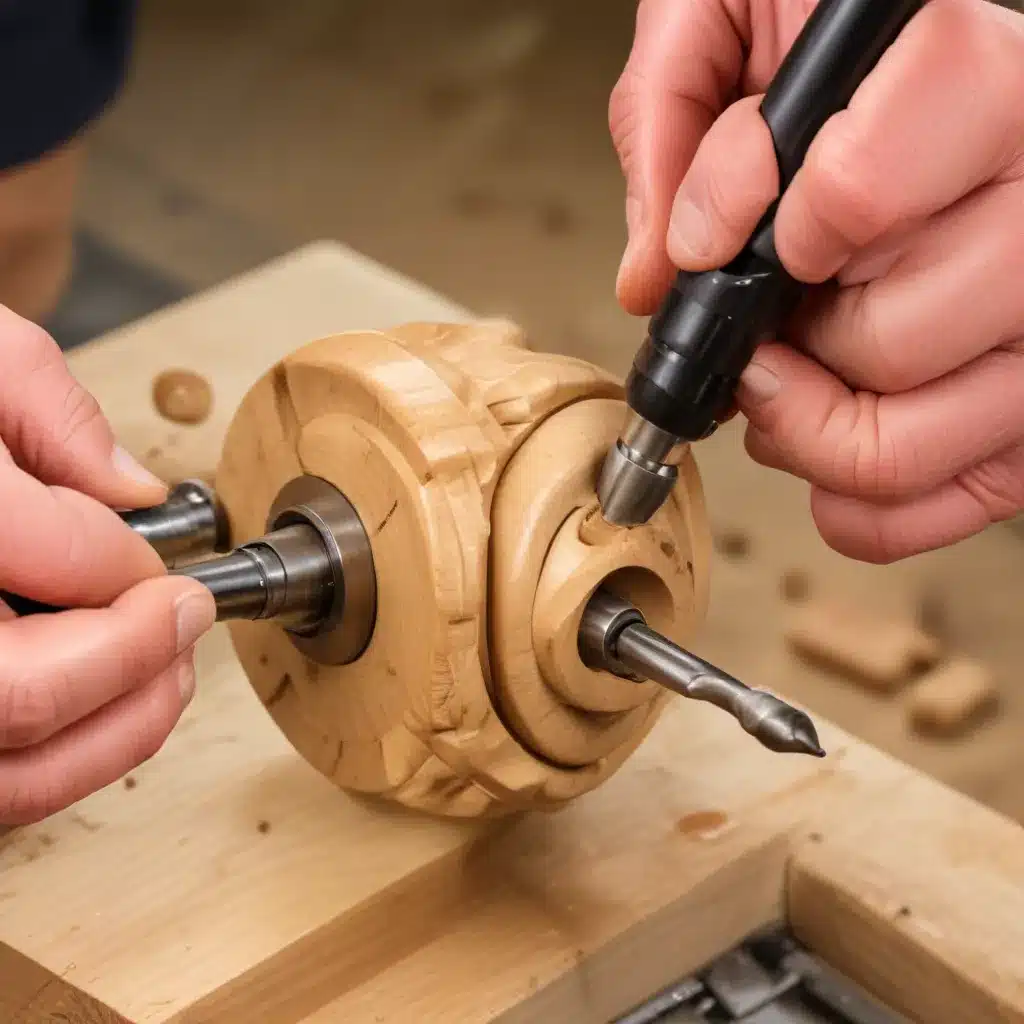
Unlocking the Secrets of Spindle Turning
As an experienced woodworker, I can confidently say that spindle turning is the foundation for honing your skills in the world of woodturning. This technique, where the wood is held between the headstock and tailstock of the lathe, allows you to create a diverse array of shapes and profiles, from delicate spindles to intricate decorative pieces.
One of the key aspects of successful spindle turning is understanding tool control. The roughing gouge is your go-to tool for quickly transforming a square or rectangular blank into a smooth, cylindrical shape. By introducing the bevel and gradually working your way from high to low points, you can efficiently remove material and create an even, balanced workpiece.
Once the initial shaping is complete, the spindle gouge takes center stage. This versatile tool allows you to add intricate details, such as beads and coves, to your turnings. The key is to pay attention to the tool’s orientation and the direction of your cuts, carefully controlling the motion to achieve the desired results.
The skew chisel, often regarded as a challenging tool, is a true workhorse in the world of spindle turning. When used with proper technique, the skew can deliver a remarkably smooth and polished surface, requiring minimal sanding. Remember to approach the cut with the bevel rubbing and focus on using the middle portion of the blade to avoid potential catches.
Mastering the parting tool is also essential for spindle work. This tool allows you to precisely part off your finished piece or create a spigot for chucking purposes. While it may not provide the best finish, the parting tool is a crucial component in your arsenal.
As you progress in your spindle turning journey, don’t be afraid to experiment with different grinds and modifications on your tools. Exploring the nuances of tool geometry can unlock new possibilities and help you tailor your approach to the specific project at hand.
Conquering Face Turning Techniques
While spindle turning lays the groundwork, face turning, where the wood is held on a faceplate or in a chuck, opens up a whole new world of possibilities. This technique allows you to create bowls, platters, and other hollow forms, each with their own unique challenges and rewards.
One of the first steps in face turning is creating a secure chucking point, often in the form of a spigot or tenon. This provides a sturdy foundation for the work and ensures that your piece remains stable during the shaping process. When working with a chuck, be mindful of the tool rest position, keeping it as close to the wood as possible without causing interference.
The bowl gouge is the workhorse of face turning. Whether you prefer a standard grind or a swept-back profile, this tool allows you to efficiently remove material and shape the exterior of your piece. Remember to work from the outside edge inwards, gradually introducing the cutting edge and allowing the bevel to rub for a more controlled and confident cut.
As you progress to hollowing the interior of your work, the bowl gouge once again takes center stage. By utilizing the wings of the tool and carefully managing the depth of cut, you can create smooth, even curves and cavities. Pay close attention to your body positioning and tool control to avoid catches and ensure a safe, enjoyable turning experience.
Don’t overlook the versatility of the scraper in face turning. While not the primary shaping tool, the scraper can be invaluable for finessing the surface and achieving a silky-smooth finish. Just be mindful of the burr preparation and avoid over-reliance on this tool, as it can lead to a less desirable surface quality.
Sanding on the lathe is a remarkably efficient process, but it’s important to approach it with care and consideration. Work your way up through the grit progression, changing directions between each step to avoid unwanted patterns. Slow the lathe speed as needed to manage heat buildup and prevent potential warping or cracking of the wood.
When it comes to finishing your face-turned pieces, the options are endless. Consider the intended use and desired aesthetic when selecting finishes, ranging from food-safe oils and waxes to more durable options like lacquer or cured CA (superglue) finishes. Experiment and find the approach that best suits your creative vision and the functional requirements of the piece.
Embracing the Versatility of Woodturning
As you delve deeper into the world of woodturning, the possibilities truly become endless. From intricate box-making and captivating pyrography to eye-catching inlays and innovative laminations, the lathe can be a gateway to a multitude of creative endeavors.
Don’t be afraid to expand your skillset and explore new techniques. Piercing, carving, and the use of specialized lathes, such as the rose engine, can open up entirely new realms of artistic expression. And for those looking to turn their passion into a profession, the world of pen-making and competitive woodturning events offer exciting opportunities to showcase your craftsmanship.
Remember, the key to success in woodturning is a combination of technical mastery and a willingness to experiment. Seek out local woodturning groups, where you can learn from seasoned veterans and collaborate with fellow enthusiasts. Embrace the journey, and let your creativity shine through in every piece you create.
The Woodcraft Parts website is a treasure trove of resources and inspiration for woodworkers of all skill levels. Whether you’re in the market for high-quality turning tools, seeking expert advice, or simply looking to immerse yourself in the vibrant community, this platform is a must-visit destination.
So, let’s embark on this captivating woodturning adventure together. With the right techniques, tools, and a healthy dose of curiosity, the possibilities are truly limitless. Embrace the challenges, celebrate your successes, and most importantly, enjoy the pure pleasure of transforming raw wood into functional and visually stunning creations.